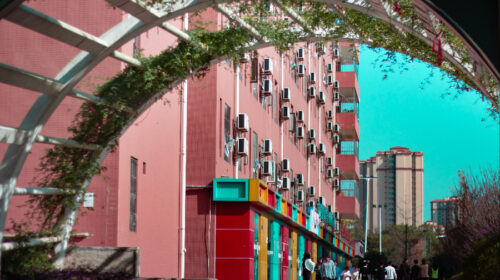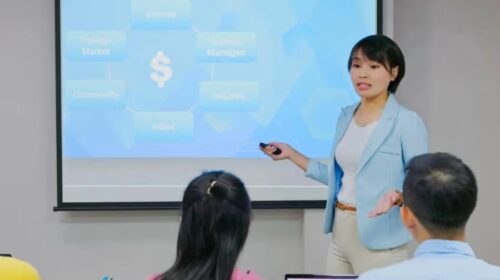Virscend Education Eyes Management Services in Its Search for New Roadmap

Company is looking to an ‘asset-light’ model for its future survival, following China’s ban of for-profit K-12 education services
Key takeaways:
- Virscend Education plans to adopt an “asset-light” model by providing services for schools developed by governments and real-estate companies
- The company lost 1.8 billion yuan in the first eight months of last year after suspending most of its K-12 education operation
By Molly Wen
China’s new education law adopted last September has provided a difficult lesson for the nation’s K-12 private educators, putting many out of business and leaving the rest struggling to survive. Last week saw one of those still standing, Virscend Education Co. Ltd. (1565.HK), belatedly publish a financial statement for the first eight months of last year as its shares continued a suspension dating back a month and a half. The statement, whose release was already delayed twice, painted a grim picture of the company’s ongoing struggles.
Virscend, which provides K-12 and college education services in Southwest China, went from the black to the red in the first eight months of last year, reporting a net loss of 1.81 billion yuan ($285 million) for the latest period. That included a 1.61 billion yuan loss related to suspension of its K-12 education operations.
The company didn’t indicate when its shares might resume trading. But at the time of the suspension, they had lost about three-quarters of their value from the start of 2021.
With the government taking an axe to private ownership of K-12 educators, finding a new road forward has become the million-dollar dilemma for an industry that has suddenly lost its main revenue source.
Regulatory clampdown
China’s latest education crackdown, while severe, continues a tradition of tightening over privately-owned educators over the years. The Non-state-owned Education Promotion Law of 2016 banned for-profit private K-12 schools, though details about its implementation weren’t spelled out at the time. Despite the uncertainty, many educational service providers went public and raised funds, with at least 12 floating shares in either the U.S. or Hong Kong since 2016.
The latest regulations take the tightening to a whole new level. They ban individuals and privately-owned enterprises from operating or controlling K-12 institutions and non-profit preschools, including through acquisitions or agreements. The move has crippled the previously vibrant group of U.S.- and Hong Kong-listed educators, many of them using the Variable Interest Entity (VIE) structure that has also come under fire, though for unrelated reasons.
Virscend stated in its statement that it no longer controlled any entities providing K-12 education services as of Aug. 31 last year, as it worked to meet the new policy requirements. That part of its operations, which previously contributed more than 40% of its revenue, had to be spun off.
The company had 11 primary schools and 11 middle schools before the spinoff. In the first half of 2021, they raked in 225 million yuan and 287 million yuan, respectively, accounting for 24% and 31% of total tuition collected. After the spinoff, the company had just nine schools.
Virscend is typical of China’s publicly listed educators, which lack diversity in their revenue streams. The company recorded 253 million yuan in revenue in the first eight months of 2021, with 81% from tuition and 12% from accommodation and boarding fees. So, it goes without saying that a drastic downsizing of its school operations is having a devastating impact on its financial performance.
The company has said that it will operate the remaining schools more efficiently and raise tuitions in the future. But its conventional high school and international high school tuitions are already as high as 58,000 yuan and 128,000 yuan respectively, meaning price increases could backfire.
The company can charge its exorbitant tuitions due to strong results getting students into China’s best universities. In the past three years, its three leading high schools landed 95.1%, 96.6% and 87.5% of their students in first-tier universities throughout China.
But in 2020 universities in Sichuan and other provinces began accepting students exclusively based on their centrally-administered college entrance exam scores. That meant the closure of other previous fast-track options, which had previously provided an alternate “back door” for entry to top universities. That switch may not bode well for Virscend’s sterling university enrollment record.
Going “Asset-Light”
Virscend is far from being the only publicly-listed educator reporting big losses these days. China Maple Leaf (1317.HK) posted a net loss of 670 million yuan on revenue of 940 million yuan for the year ended Aug. 31, 2021, while Wisdom Education (6068.HK) registered a net loss of 2.28 billion yuan during the same period compared to a 500 million yuan profit a year before.
With the deck so heavily stacked against them, how can these privately-owned K-12 educators survive the current crisis? A top choice is expanding into online and higher education, including establishment of their own universities. Wisdom Education has chosen that path. Others are trying an “asset-light” route by peddling their expertise in school operation to provide education industry know-how. That route requires former educators to provide school operation services to governments and real-estate developers who can still legally build and operate schools.
Soochow Securities believes that more resources can be invested in school management and teacher training under this model, which can help improve the quality of education. At the same time, such partnerships can bring down costs for management services providers, allowing them to quickly expand their school networks and boost revenue.
In its financial statement, Virscend Education noted that it would try that route by establishing new high schools with business partners under an “asset-light” model, with plans to operate six high schools under the model post-2022. It added that it would also provide education management and consultation services to K-12 schools. But that part of its operation only yielded a modest 1.8 million yuan in revenue in the first eight months of 2021.
As they fell deeply into the loss column and their revenues shriveled, Virscend, China Maple Leaf and Wisdom Education saw their price-to-sales (P/S) ratios settle at around 3.04 times, 2.4 times and 4.7 times, respectively, by the start of this week. Virscend’s middle-of-the-pack valuation – perhaps inflated by the suspension of its shares – suggests investors are taking a wait-and-see attitude toward the company for now.
However, Chu Chaohui, a researcher from National Institute of Education Sciences, believes it will be impossible for privately-owned education companies to sustain profitability or even stay afloat merely by providing school operation and management services to others. Only time will tell, and investors may have to wait and see whether the light-asset model is really viable in the long run.
To subscribe to Bamboo Works free weekly newsletter, click here





